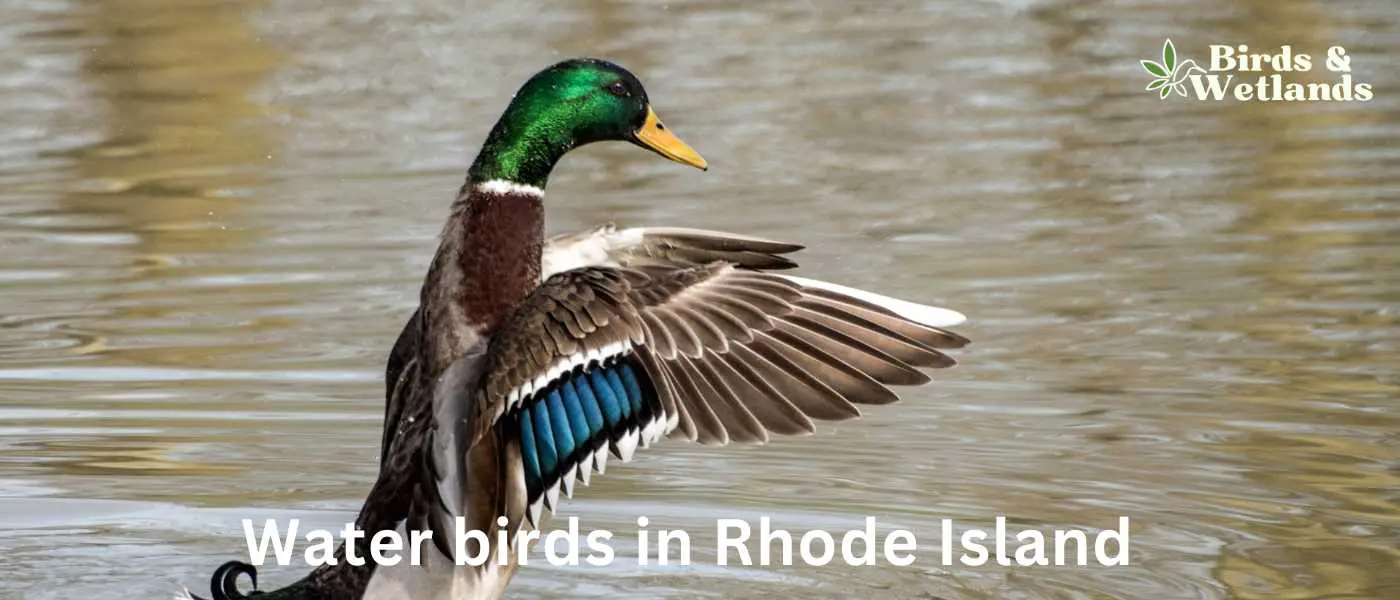Rhode Island, America’s smallest state, is a veritable paradise for water bird enthusiasts with distinct species dotting the coastlines and wetlands. The diverse ecosystems that this Ocean State provides form a thriving habitat for these feathered inhabitants.
Rhode Island water birds
The state of Rhode Island, being located on the Atlantic coast, is a haven for many different species of water birds. Here is a list of some of the most common water birds that you might encounter in the state:
| Bird Species | Commonality | Best Location to Find |
|---|---|---|
| Mallard | Very common | Roger Williams Park |
| Canada Goose | Very common | Trustom Pond NWR |
| American Black Duck | Very common | Sachuest Point NWR |
| Hooded Merganser | Common | Ninigret NWR |
| Ring-necked Duck | Common | Goddard Memorial State Park |
| Common Loon | Common | Block Island |
| Red-breasted Merganser | Common | Beavertail State Park |
| Bufflehead | Common | Narragansett Bay |
| Great Blue Heron | Common | Galilee Bird Sanctuary |
| Green Heron | Common | Fishermen’s Memorial State Park |
| Snowy Egret | Common | Sachuest Point NWR |
| Great Egret | Common | Trustom Pond NWR |
| Osprey | Common | Charlestown Breachway |
| Belted Kingfisher | Common | Roger Williams Park |
| Double-crested Cormorant | Very common | Jamestown Shoreline |
| American Coot | Common | Alton Jones Campus |
| Herring Gull | Very common | Scarborough State Beach |
| Ring-billed Gull | Very common | Block Island |
| Black-crowned Night-Heron | Common | Conimicut Point Park |
| Red-throated Loon | Common | Newport Harbor |
| American Wigeon | Common | Goddard Memorial State Park |
| Common Goldeneye | Common | Watchaug Pond |
| Greater Scaup | Common | Ninigret NWR |
| Lesser Scaup | Common | Sachuest Point NWR |
| Northern Pintail | Common | Trustom Pond NWR |
Water Bird Species Found in Rhode Island
Mallard
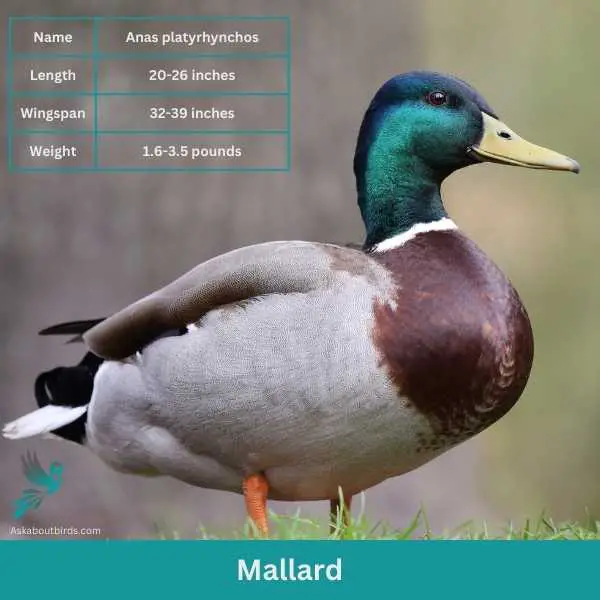
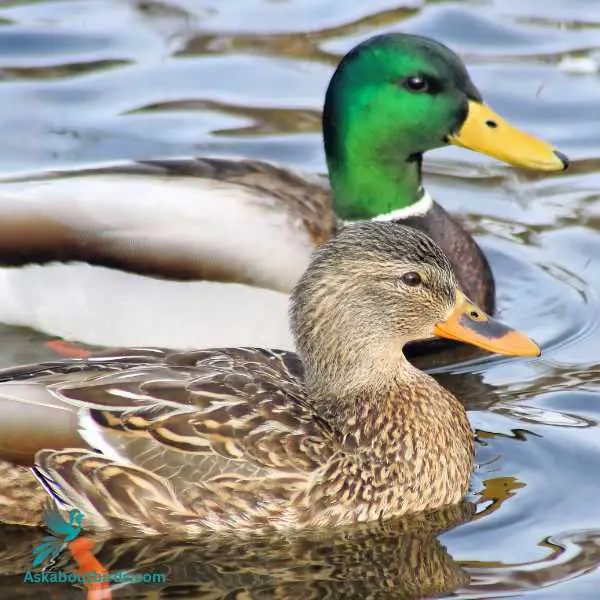
| Feature | Measurement |
|---|---|
| Scientific Name | Anas platyrhynchos |
| Length | 20-26 inches |
| Wingspan | 32-39 inches |
| Weight | 1.6-3.5 pounds |
The Mallard, one of the most recognizable of all ducks, is distinguished by its classic “quack” and its common presence in city parks and wild wetlands.
Appearance: Mallards are large ducks with a hefty body and rounded head. The male is notable for its glossy green head, gray body, and black tail-curl, while the female is mottled brown with an orange-brown bill. Both sexes have a white-bordered, blue “speculum” patch in the wing.
Diet: Mallards are omnivorous, dabbling ducks that eat a wide variety of foods. They are known to feed on aquatic vegetation, insects, worms, and grains. In city parks, they are often seen eating bread, popcorn, and other food provided by humans, although such items are not part of their natural diet.
Reproduction: Mallards nest on the ground on dry land that is close to water, under cover of tall grass or other vegetation. The female typically lays around 8 to 13 eggs and incubates them herself.
Canada Goose
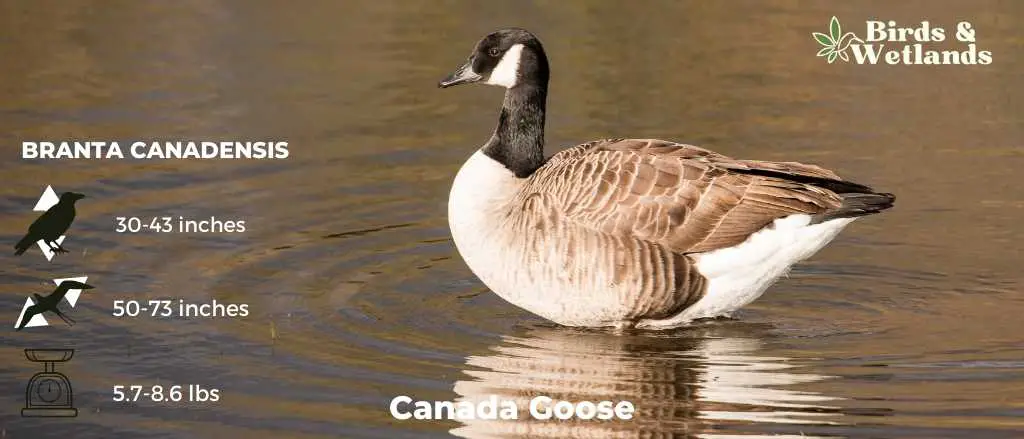
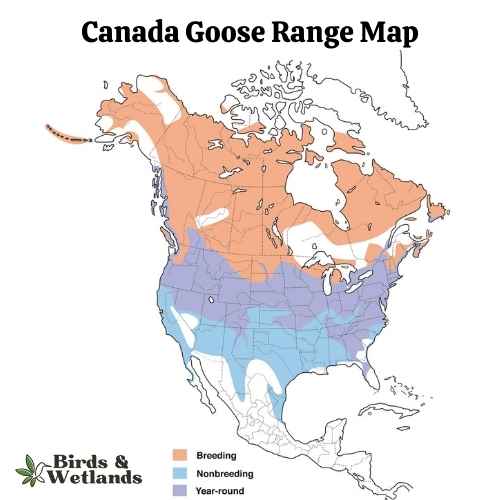
Canada Goose Sound
Scientific Name: Branta canadensis
Length: 30 to 43 in
Wingspan: 50–73 in
Weight: 5.7–14.3 lb
The Canada Goose is a large, well-known species of waterfowl noted for its distinctive appearance, familiar “honk,” and migratory behavior.
Appearance: Both male and female Canada Geese have a similar appearance, featuring a black head and neck with distinctive white patches on the cheeks and chin. The body is primarily brown with a lighter, often white, underbelly.
Diet: Canada Geese primarily feed on plant matter, including grasses, aquatic vegetation, and grains. They can often be seen grazing in parks, lawns, and fields, as well as dabbling in water bodies.
Reproduction: Canada Geese typically nest on the ground near water bodies, often on islands or other isolated areas to avoid predators. The female lays a clutch of about 4 to 6 eggs, which she incubates alone for around a month.

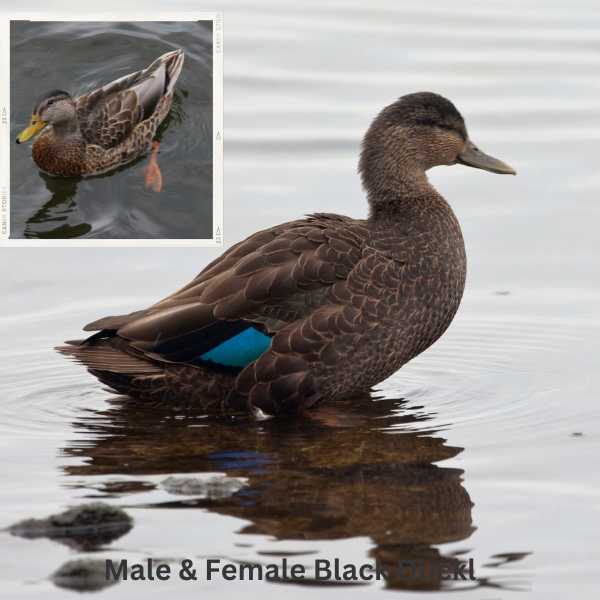
Listen
Scientific Name: Anas rubripes
Length: 21–23 in
Wingspan: 35–37 in
Weight: 1.59–3.62 lb
The Black Duck is a relatively large species of waterfowl known for its dark plumage and distinctive, richly flavored meat.
Appearance: Both male and female Black Ducks sport a similar look. They are predominantly dark brown in color with a lighter, beige-colored underbelly. They feature a yellowish-green bill, and their wings, when spread, reveal a purple-blue speculum bordered by two black bands.
Diet: Black Ducks primarily subsist on plant matter. They feed on seeds, leaves, and roots of aquatic plants, as well as grasses and crops. In addition, they sometimes eat small fish, insects, and aquatic invertebrates. These ducks can often be spotted foraging in shallow water bodies and marshlands.
Reproduction: Black Ducks typically create their nests on the ground, preferably in secluded, well-hidden spots near water bodies. The female usually lays a clutch of about 6 to 12 eggs, which she incubates for about four weeks.
Hooded Merganser
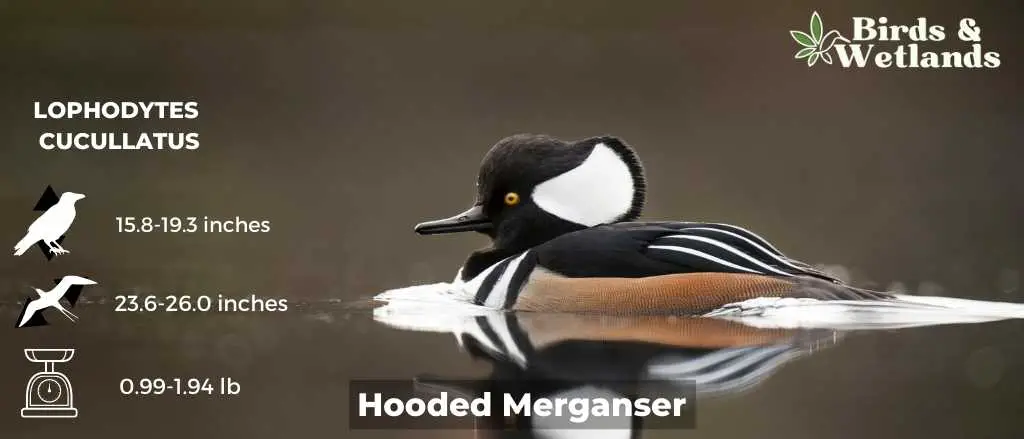
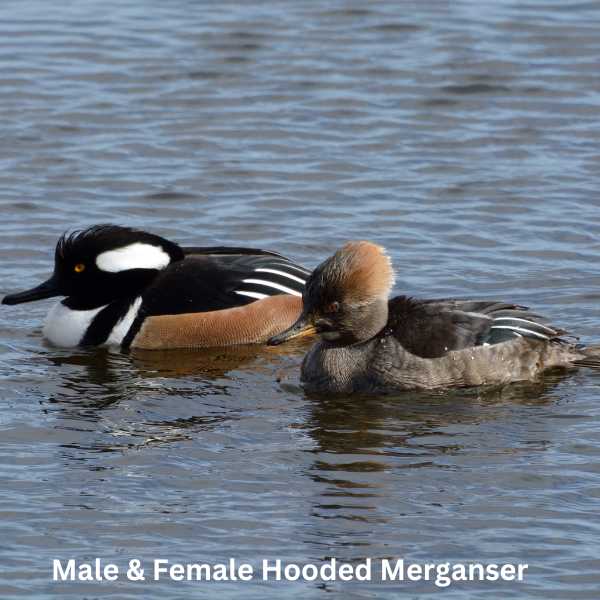
Listen to Hooded Merganser
Scientific Name: Lophodytes cucullatus
Length: 15.8-19.3 in
Wingspan: 23.6-26.0 in
Weight: 16.0-31.0 oz
The Hooded Merganser is a distinctive species of diving duck known for its showy crest and its excellent diving skills.
Appearance: Male Hooded Mergansers are especially striking with a large, fan-shaped, black and white crest, which can be expanded or contracted. They have bright yellow eyes, a dark back, and a white chest. The females have a more understated appearance with a brownish body, a smaller, reddish-brown crest, and dark eyes.
Diet: Consists of small fish, aquatic insects, and crustaceans. Their eyes are specially adapted for underwater vision, allowing them to spot and catch prey while diving.
Reproduction: Similar to Buffleheads, Hooded Mergansers often nest in tree cavities near water bodies. The female lays a clutch of about 10 to 12 eggs and incubates them alone for about a month.
Ring-necked Duck (Aythya collaris)
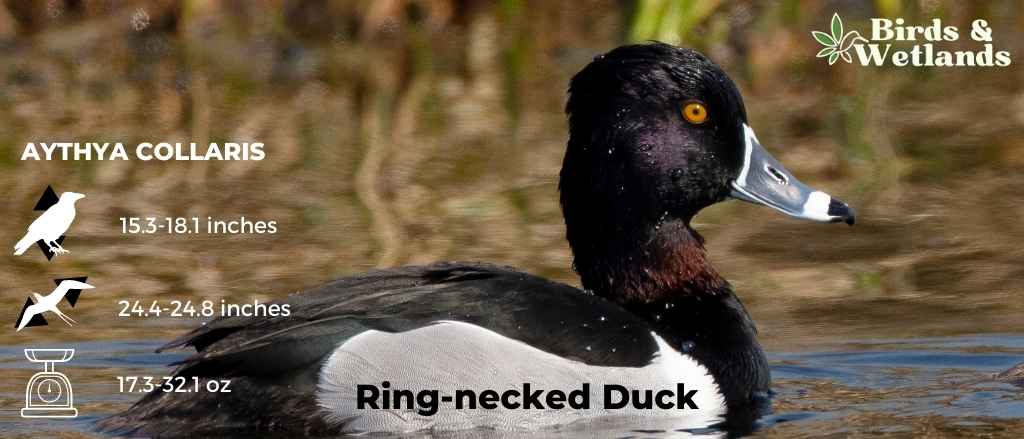

Listen
Scientific Name: Aythya collaris
Length: 15.3-18.1 in
Wingspan: 24.4-24.8 in
Weight: 17.3-32.1 oz
The Ring-Necked Duck is a small to medium-sized diving duck known for its distinctive markings and agile diving abilities.
Appearance: Male Ring-Necked Ducks are characterized by their bold black-and-white coloration, with a glossy black back, a striking white ring around the base of the bill, and two white “rings” on their flanks. Despite their name, the chestnut-colored ring around their neck is often hard to see. Females are more subtly colored with a gray-brown body and a white eye-ring.
Diet: These ducks have a varied diet that includes aquatic plants, seeds, and invertebrates, which they obtain by diving underwater in both shallow and deep water bodies.
Reproduction: The Ring-Necked Duck nests near water, often in densely vegetated areas. The female typically lays between 8 to 10 eggs, which she incubates alone, but both parents will care for the ducklings once they hatch.
Common Loon

Listen:
Scientific Name: Gavia immer
Length: 24-39 in
Wingspan: 50-56 in
Weight: 6.4-13.6 lbs
The Common Loon is a large, iconic water bird that can be found in many parts of North America. It is known for its haunting calls, often heard in the early morning or late evening across the region’s lakes and ponds.
Appearance: The Common Loon is celebrated for its striking black-and-white breeding plumage, a red eye, and a robust, black bill. In winter, its plumage turns to a more subdued gray, but its large, sturdy body and pointed bill remain distinctive.
Diet: Common Loons primarily feed on fish, but also consume crustaceans, frogs, and aquatic insects. They are expert divers, capable of plunging deep underwater to catch their prey, and are often observed popping their heads above water before diving for their next meal.
Reproduction: The Common Loon nests near water, typically on lakes and larger ponds in the northern parts of North America. The female generally lays 1-2 eggs per year in a nest made from vegetation on the ground. Both parents share the responsibility of incubating the eggs and feeding the young.
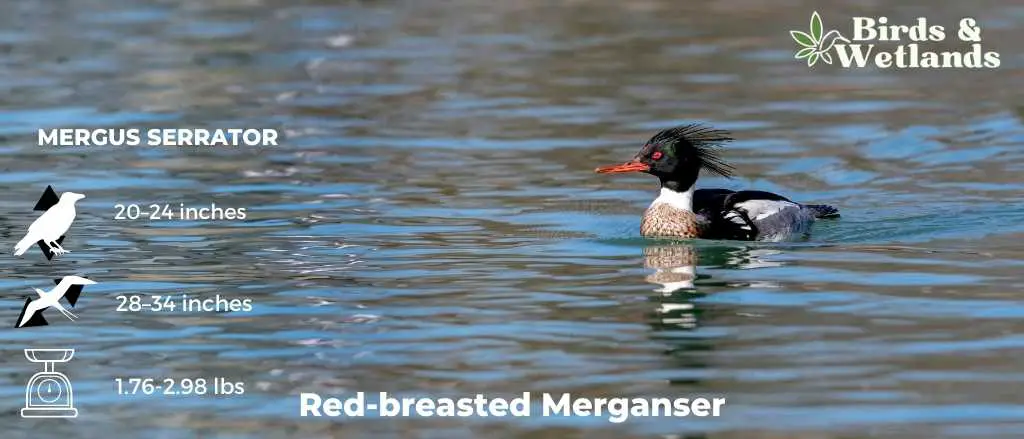

Listen
Scientific Name: Mergus serrator
Length: 20–24 in
Wingspan: 28–34 in
Weight: 28.2 to 47.6 oz
The Red-breasted Merganser is a fascinating diving duck species, recognized for its swift flight and exceptional diving capabilities. They inhabit freshwater and saltwater environments and are quite common in North America and Eurasia.
Appearance: The Red-breasted Merganser boasts an interesting appearance. Males display a dark green head, bright red eyes, and a distinctive, long reddish-brown breast. Their bodies are mainly grey, and they also have a white collar and a thin, serrated bill. Females are more subdued, featuring a rusty cinnamon head with a shaggy crest and grey body.
Diet: Predominantly includes small fish, which they catch by diving underwater. They can also feed on aquatic insects, crustaceans, and occasionally amphibians. Their serrated bill helps them grip slippery prey effectively.
Reproduction: The breeding ground for Red-breasted Mergansers is typically near freshwater lakes or rivers. Females build nests in tree cavities, on the ground hidden in vegetation, or use abandoned nests of other birds. The female lays a clutch of 6 to 12 eggs.
Bufflehead
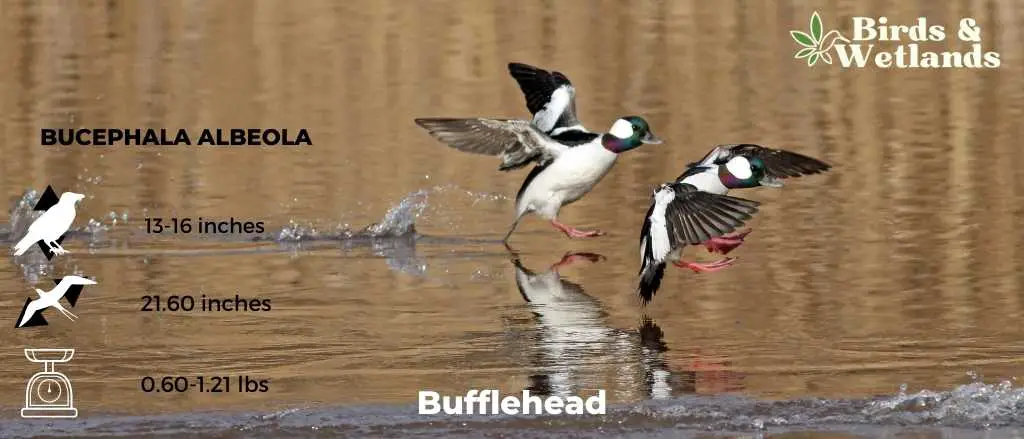
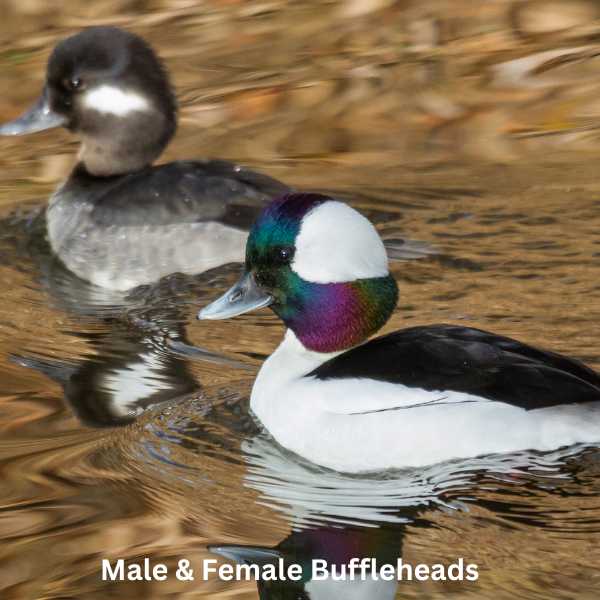
Listen to Bufflehead
Scientific Name: Bucephala albeola
Length: 13–16 in
Wingspan: 21.6 in -23.2 in
Weight: 9.5–19.4 oz
The Bufflehead is a small, compact species of diving duck known for its striking appearance and large heads and unique nesting habits.
Appearance: Male Buffleheads are easily recognized by their large, bulbous head with a green-purple iridescent sheen, a large white patch across the back of the head, and a predominantly black and white body. Females are more subtly colored, primarily in gray-brown tones with a smaller white cheek patch.
Diet: As diving ducks, Buffleheads feed by diving beneath the water’s surface. Their diet consists largely of aquatic invertebrates, such as insects, crustaceans, and mollusks, as well as some plant matter.
Reproduction: Uniquely among ducks, Buffleheads often nest in tree cavities, especially those made by Northern Flickers, a type of woodpecker. The female lays a clutch of about 6 to 11 eggs, which she incubates alone for roughly a month.
Great Blue Heron


| Feature | Measurement |
|---|---|
| Scientific Name | Ardea herodias |
| Length | 36–54 in |
| Wingspan | 66–79 in |
| Weight | 1.82–3.6 kgs |
Great Blue Herons are the largest heron species in North America, is distinguished by its tall stature and unique blue-gray plumage.
Measuring up to 4.5 feet tall with a wingspan of approximately 6.5 feet, the bird features a long, pointed bill, a white head with a black eye stripe extending to slender black plumes, and robust, elongated legs. Its distinctive flight pattern, forming a tight “S” shape with its neck, sets it apart from similar large birds, like cranes.
Inhabiting various wetland habitats, including marshes, lakes, rivers, and coastal regions throughout much of North and Central America, the Great Blue Heron is a wading bird. Often seen poised statue-like at the water’s edge, these birds are expert hunters, spearing fish and capturing small animals with their sharp bills.
Green Heron

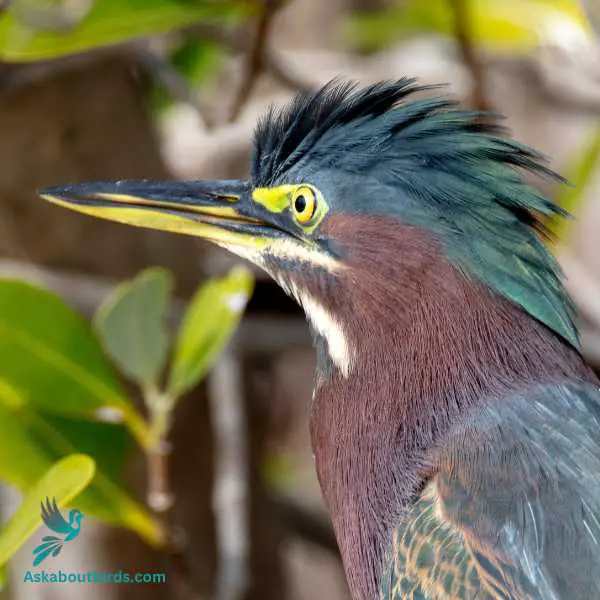
| Feature | Measurement |
|---|---|
| Scientific Name | Butorides virescens |
| Length | 16-18 inches |
| Wingspan | 25-27 inches |
| Weight | 6-7 ounces |
The Green Heron is a small heron found in North America, notable for its deep green back and chestnut body, as well as its unique fishing tactics.
Appearance: Green Herons are dark and compact birds with a glossy, greenish-black cap, a greenish back and wings, and chestnut neck and belly. The bill is long, dark and sharply pointed. Their legs are bright orange or yellow. Young birds are duller in color, with a dark top and streaked brown front.
Diet: The Green Heron’s diet is quite varied, consisting mostly of small fish, but also includes insects, spiders, and sometimes amphibians and small mammals. It’s known for its tool-using behavior where it drops bait onto the water’s surface to attract fish.
Reproduction: Green Herons are solitary birds except during the breeding season, where they form monogamous pairs. Nests are typically built in trees or shrubs near water. Females lay 2 to 5 pale blue-green eggs that both parents incubate.
Snowy Egret

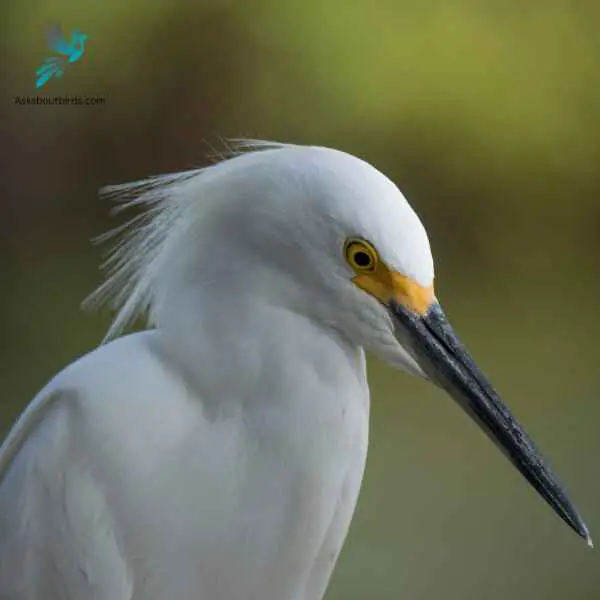
| Feature | Measurement |
|---|---|
| Scientific Name | Egretta thula |
| Length | 22.1–26.0 in |
| Wingspan | 39.4 in |
| Weight | 370 g |
The Snowy Egret (Egretta thula) is a small and active wading bird, celebrated for its delicate beauty. It sports an entirely white plumage that appears to glow against its black bill and legs, and striking yellow feet, which often play a crucial role in luring prey during feeding.
The Snowy Egret is further adorned with fine, plume-like feathers on its head, neck, and back during the breeding season, making it one of the more distinctive heron species.
Inhabiting wetland areas across the Americas, the Snowy Egret can be found in marshes, swamps, shorelines, and tidal flats where it feeds primarily on fish, but also consumes insects, crustaceans, and small reptiles.
Great Egret


| Feature | Measurement |
|---|---|
| Scientific Name | Ardea alba |
| Length | 31 to 41 in |
| Wingspan | 52 to 67 in |
| Weight | 1.5 to 3.3 lbs |
The Great Egret (Ardea alba), also known as the Common Egret, is a large, elegant wading bird recognized for its brilliant white plumage, slender black legs, and long, dagger-like yellow bill.
With a height of up to 3.3 feet and a wingspan of 52 to 67 inches, this bird is amongst the largest of the heron species. Its stately appearance and serene comportment have made it a popular symbol in many cultures and an eye-catching sight in its habitats.
Found across all continents except Antarctica, the Great Egret resides in both fresh and saltwater wetlands, including marshes, ponds, and coastal areas. It feeds mainly on fish, but it also hunts amphibians, small mammals, and invertebrates.
Osprey (Pandion haliaetus)
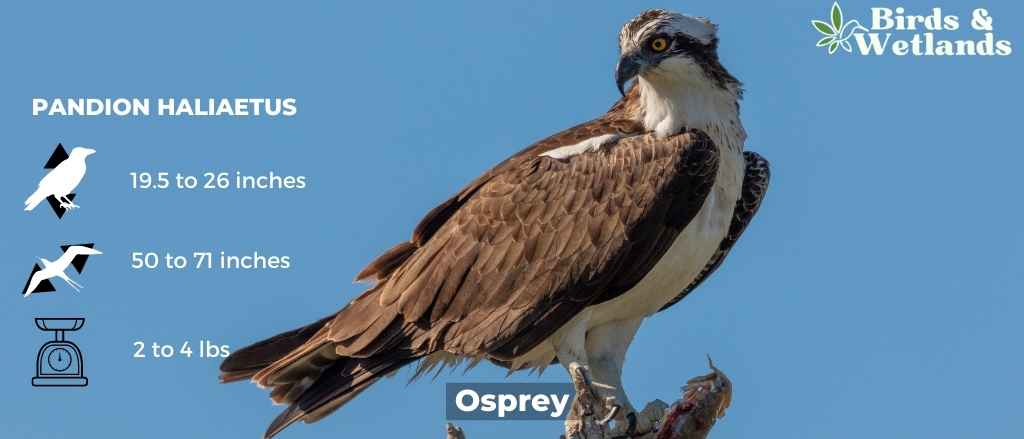
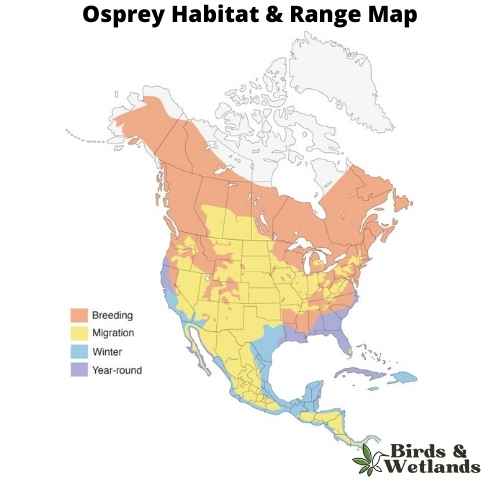
Osprey Sound
Scientific Name: Pandion haliaetus
Length: 50–66 cm (19+1⁄2–26 in)
Wingspan: 127–180 cm (50–71 in)
Weight: 0.9–2.1 kg (2 lb 0 oz – 4 lb 10 oz)
The Osprey, a fascinating bird of prey, is universally known for its exceptional hunting prowess and striking physical characteristics. Osprey are dark brown hawks on the upperparts, contrasting beautifully with the predominantly white underparts, and a distinctive dark band that stretches across the eyes towards the sides of its head.
Equipped with specialized talons and a reversible outer toe, the Osprey’s hunting strategy involves a spectacular plunge-dive into bodies of water, often emerging with a fish securely gripped in its claws.
Found on every continent except Antarctica, the Osprey is a cosmopolitan species favoring habitats near water bodies such as lakes, rivers, and coastal areas, reflecting its piscivorous diet. This bird has a diet almost exclusively of fish, making it a unique member of the raptor family and often referred to as the sea hawk or fish hawk. They locate their prey from the air, often hovering before plunging feet-first to capture a fish. When it comes to breeding, Ospreys are monogamous, often mating for life.
They construct large, bulky nests made of sticks, lined with softer materials, and prefer elevated or isolated areas such as treetops or artificial structures like utility poles. Both parents share the responsibility of incubating the eggs and rearing the chicks.
Belted Kingfisher (Megaceryle alcyon)
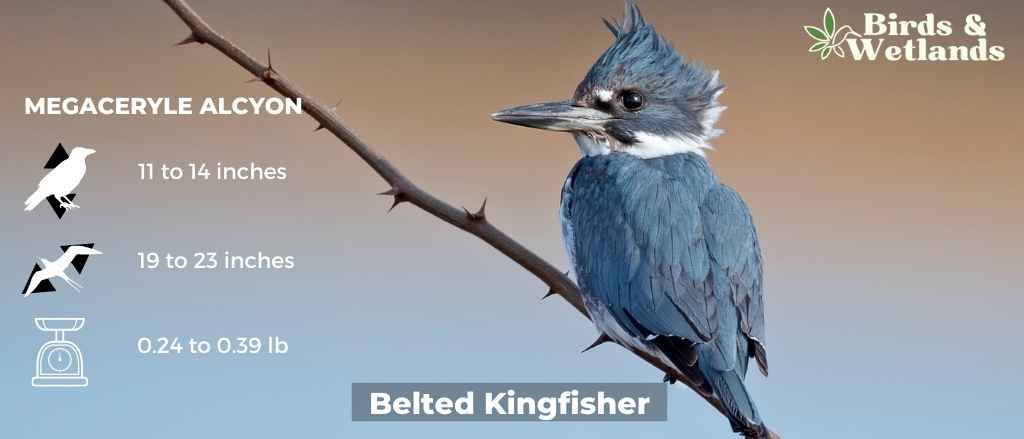
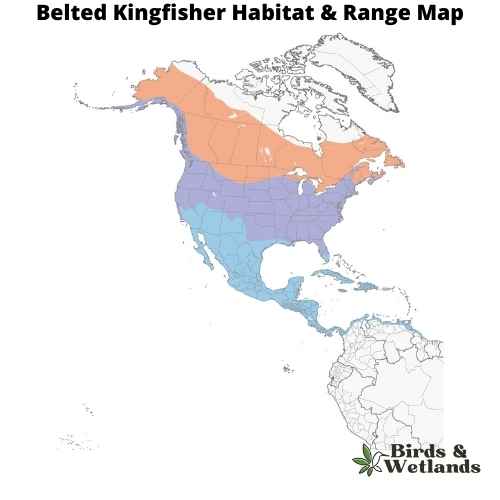
Listen
Scientific Name: Megaceryle alcyon
Length:11–14 in
Wingspan: 19–23 in
Weight: 4.0 to 6.3 oz
The Belted Kingfisher is a conspicuous water bird, known for its distinct rattling call and impressive diving abilities.
Appearance: The Belted Kingfisher is characterized by a large head with a shaggy crest and a long, thick bill. They have a blue-gray body with white underparts. A defining characteristic is the blue-gray band, or “belt,” across the chest. Males and females have similar coloration, but females have an additional chestnut-colored band on their bellies.
Diet: Belted Kingfishers are excellent fishermen, often seen perched above water bodies, such as rivers, streams, lakes, and ponds, watching for their prey. They primarily feed on fish but will also eat amphibians, crustaceans, insects, small mammals, and reptiles. They hunt by diving headfirst into the water to catch their prey.
Reproduction: Belted Kingfishers nest in burrows that they excavate in sandy or earthy banks, usually near a body of water. These burrows can be up to 8 feet deep. The female lays a clutch of 5 to 8 eggs, and both parents participate in incubation and feeding of the young.
Double-crested cormorant

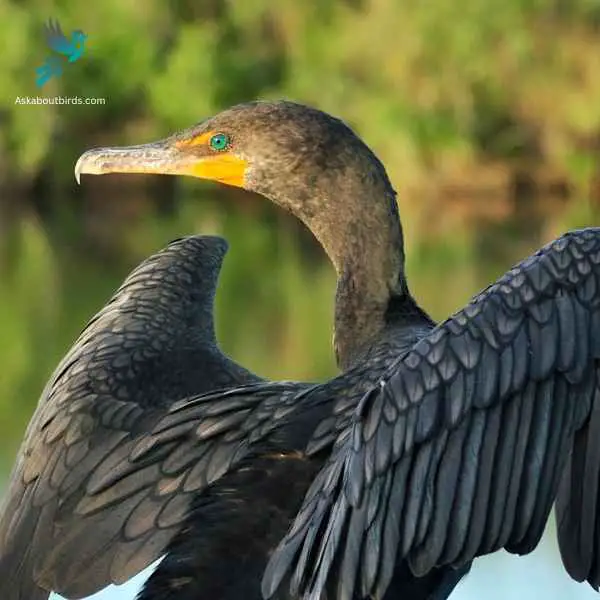
| Feature | Measurement |
|---|---|
| Scientific Name | Nannopterum auritum |
| Length | 28–35 in |
| Wingspan | 45–48 in |
| Weight | 1.2–2.5 kg |
The Double-Crested Cormorant (Phalacrocorax auritus) is a large waterbird known for its long neck, hooked bill, and almost entirely black body. The species gets its name from the two small patches of tufted feathers or “crests” found on the heads of breeding adults, one on each side. These birds are strong swimmers that propel themselves underwater with their webbed feet, their bodies submerged and necks above the water surface, giving them a characteristic snake-like appearance when swimming.
Double-Crested Cormorants are widely distributed across North America and can be found in a variety of aquatic environments including freshwater lakes, coastal areas, and rivers. Their diet primarily consists of fish, which they catch by diving from the water’s surface. Often seen perched with wings outstretched to dry after fishing, these cormorants nest in trees, on the ground, or on cliff edges, usually in colonies. While they have rebounded from decreases in the mid-20th century due to DDT-related reproductive failures, they face ongoing threats from habitat loss, entanglement in fishing gear, and conflicts with fisheries over their consumption of fish. Protection and careful management of their habitats are key to their ongoing conservation.
American Coot
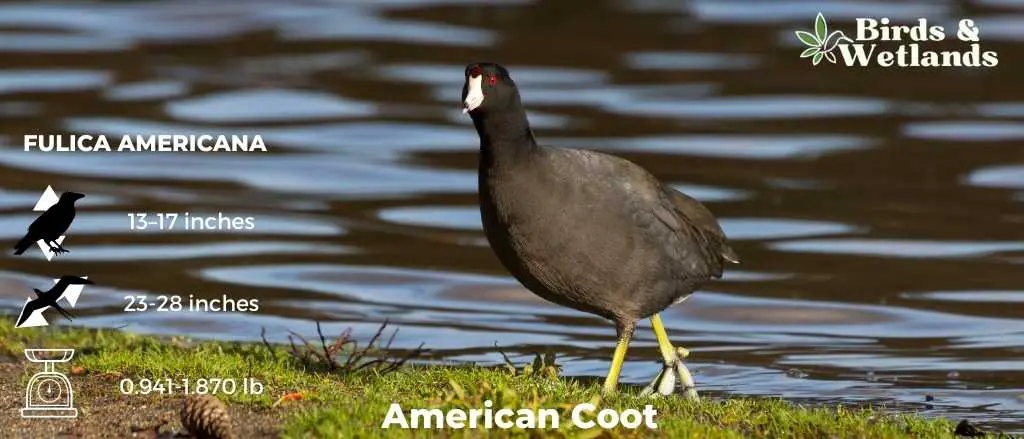
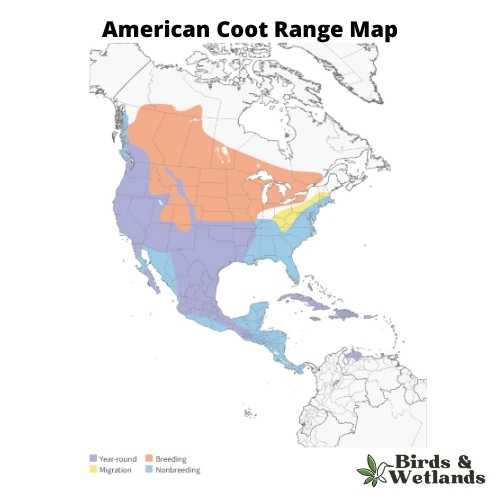
Listen:
Scientific Name: Fulica americana
Length: 13–17 in
Wingspan: 23 to 28 in
Weight: 1.270 to 1.870 lb
The American Coot is a ubiquitous water bird commonly seen in the wetlands, lakes, and ponds of North America, recognized for its adaptability and striking features.
Appearance: American Coots are easily identifiable by their slate-gray bodies, offset by a white, chicken-like bill and a red eye. Their legs are also distinctive, equipped with lobed toes, as opposed to the webbed feet seen in ducks, which assist them in navigating both land and water adeptly.
Diet: While aquatic plants form the bulk of an American Coot’s diet, they aren’t strictly herbivores. These versatile birds also consume small invertebrates and fish, demonstrating their ability to adapt and survive in a variety of habitats.
Reproduction: Nesting for the American Coot usually happens in shallow water bodies, where they construct a floating nest hidden among the vegetation. A clutch can contain between 8 to 12 eggs, all of which are incubated by both parents.
Herring Gull (Larus argentatus)


Listen:
Scientific Name: Larus argentatus
Length: 22.1-26.0 in
Wingspan: 53.9–57.5 in
Weight: 28.2-44.1 oz
The Herring Gull is a versatile bird often found near coastlines, known for its distinct call and adaptive lifestyle.
Appearance: Herring Gulls have a white body, gray back, and yellow bill with a red spot. Juvenile gulls are brown, becoming whiter as they age.
Diet: These gulls are opportunistic eaters. They consume a variety of food, including fish, insects, small birds, carrion, and human refuse.
Reproduction: Herring Gulls nest in colonies on islands or cliffs, laying two to three eggs per season. Both parents share incubation and chick-raising responsibilities.
Ring-billed Gull (Larus delawarensis)
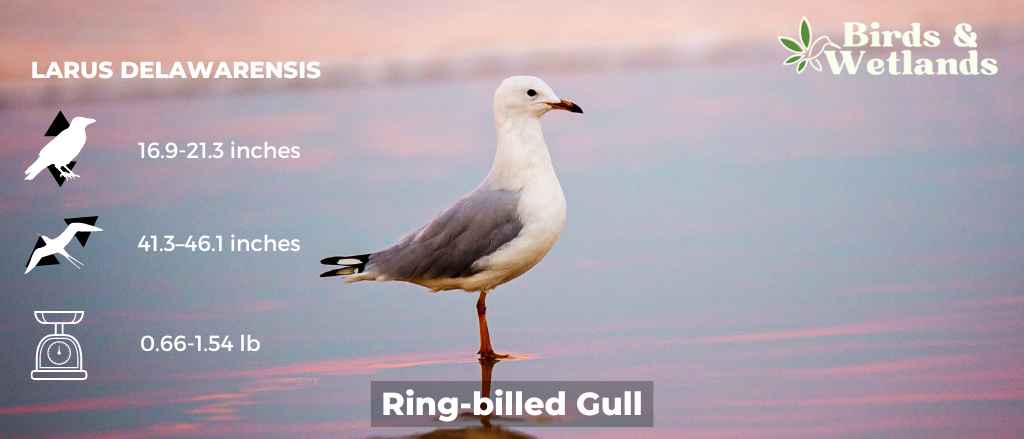
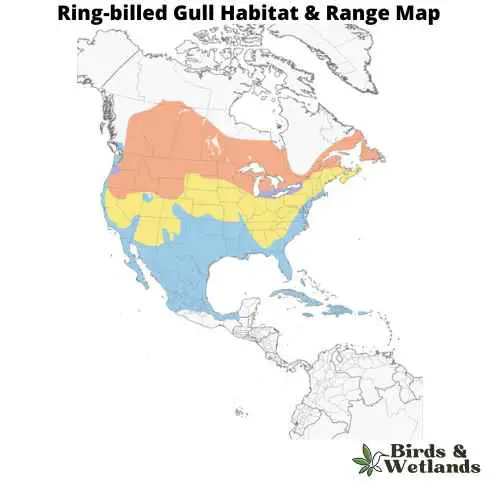
Listen:
Scientific Name: Larus delawarensis
Length: 16.9-21.3 in
Wingspan: 41.3–46.1 in
Weight:10.6-24.7 oz
The Ring-billed Gull is a common North American gull species recognized for its distinctive bill markings and widespread presence, particularly around human habitats.
Appearance: Ring-billed Gulls have a light-gray back, white head and underparts, and yellow eyes. Their most notable feature is the black ring around their yellow bill, which gives the species its name.
Diet: They have a varied diet that includes fish, insects, earthworms, rodents, grain, and garbage. They’re known for their opportunistic and scavenging feeding behaviors, often found near human-populated areas.
Reproduction: Ring-billed Gulls typically nest in large colonies on the ground near bodies of water. The female usually lays two to three eggs per season.
Black-Crowned Night-Heron
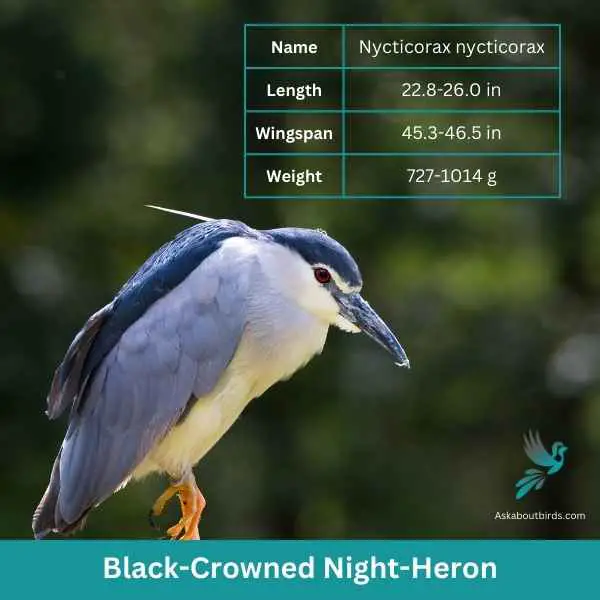
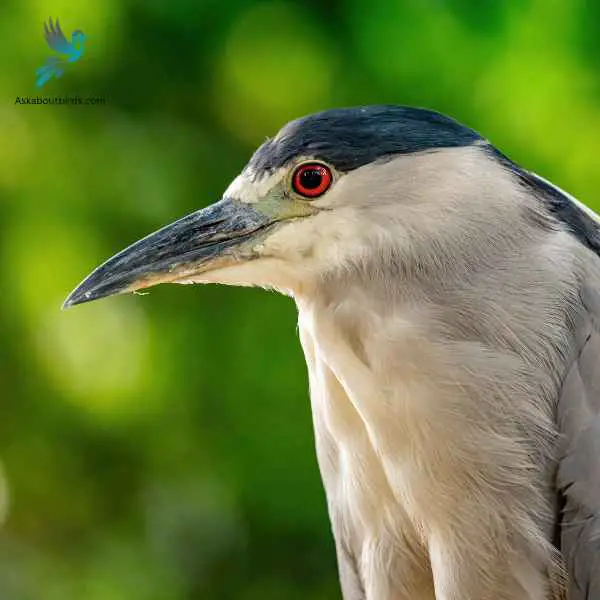
| Feature | Measurement |
|---|---|
| Scientific Name | Nycticorax nycticorax |
| Length | 22.8-26.0 in |
| Wingspan | 45.3-46.5 in |
| Weight | 727-1014 g |
The Black-Crowned Night-Heron (Nycticorax nycticorax) is a medium-sized heron species known for its distinct nocturnal habits and characteristic appearance. The bird displays a stocky silhouette, with a black crown and back, contrasting starkly with its light grey wings and white underparts.
Its eyes are large and red, adapted for its night-time activities, and its legs are relatively short for a heron. The bill is sturdy and black, and during the breeding season, two to three long white plumes extend from the back of the head.
Residing in a wide variety of wetland habitats, from freshwater marshes to coastal regions, the Black-Crowned Night-Heron is found across a large global range, including the Americas, Europe, Asia, and Africa. The species primarily feeds on fish and invertebrates, but it is known to be opportunistic and will also eat small mammals, birds, and eggs.
Red-throated Loon (Gavia stellata)
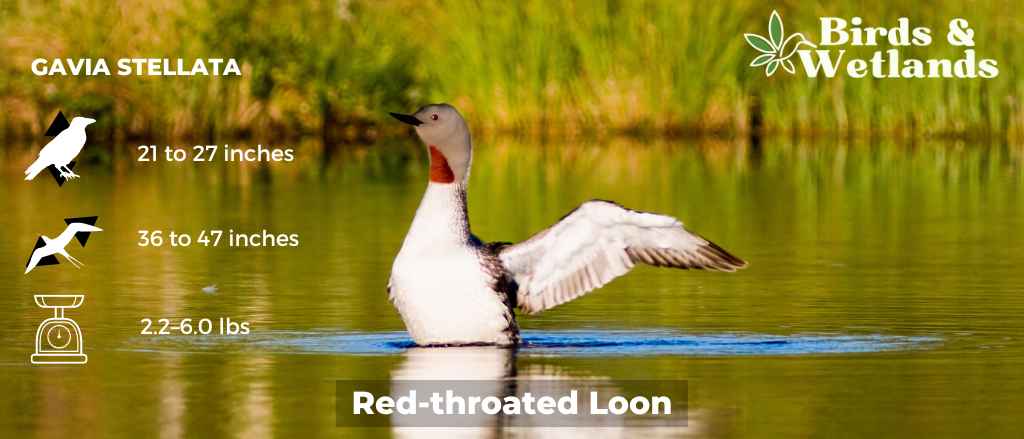
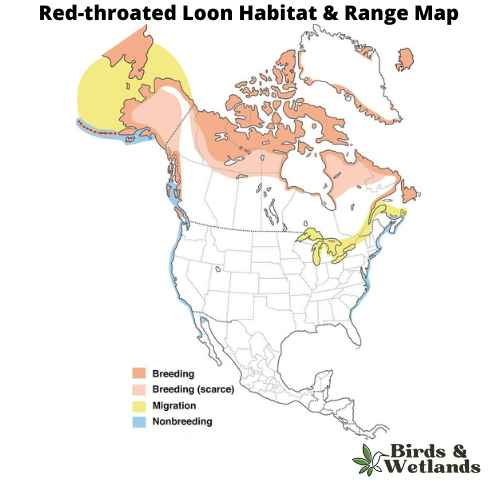
Listen:
Scientific Name:Gavia stellata
Length: 21 to 27 in
Wingspan: 36–47 in
Weight:2.2–6.0 lb
The Red-throated Loon is a migratory bird known for its distinctive red throat patch during breeding season and its elegant diving skills.
Appearance: Red-throated Loons are sleek birds with pointed bills that tilt upward slightly. They have a gray-brown body, white underparts, and a distinctive red throat patch in summer, which is replaced by gray-white coloring in winter.
Diet: They primarily feed on fish but will also eat aquatic invertebrates. Noted for their diving skills, they catch their prey underwater, often diving from the surface and swimming powerfully using their feet for propulsion.
Reproduction: Red-throated Loons nest close to water, usually on bare ground or among vegetation. Typically, the female will lay two eggs per season.
American Wigeon
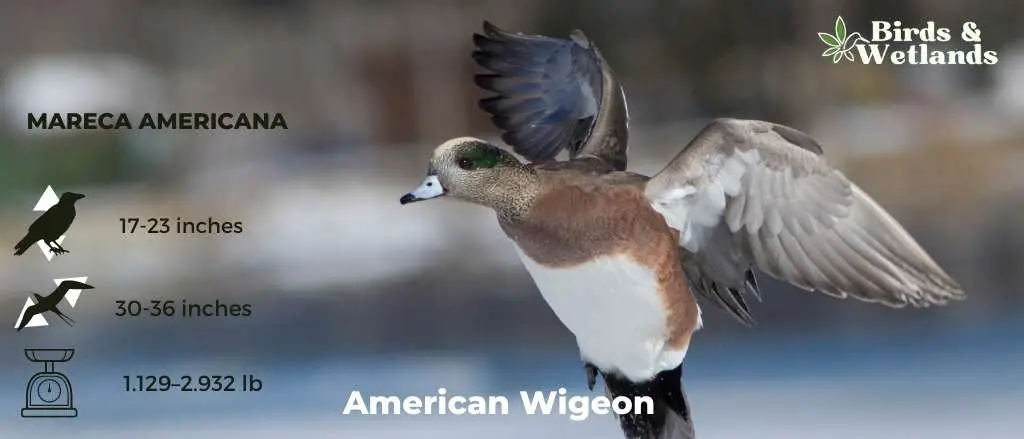
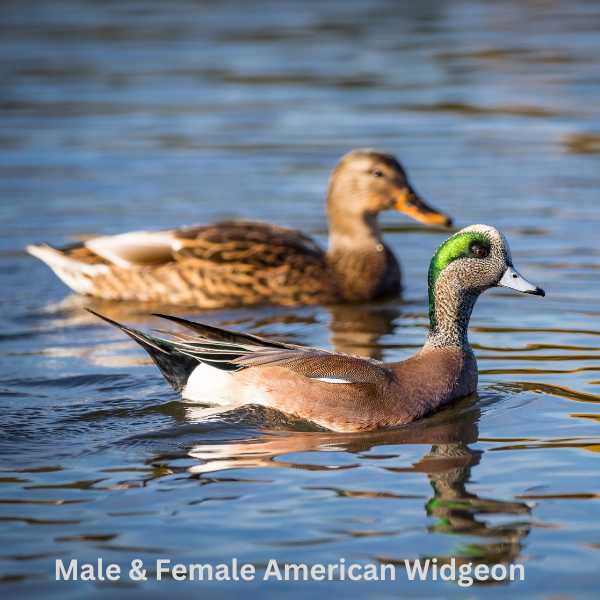
Listen to American Wigeon
Scientific Name: Mareca americana
Length: 17–23 in
Wingspan: 30–36 in
Weight: 1 –3 lb
The American Wigeon is a medium-sized duck species that is a popular sight in wetlands, ponds, and lakes and is often seen in mixed flocks with other ducks.
Males of the species are recognized by their distinctive appearance. They sport a unique white forehead and crown, coupled with a green band stretching from the eye to the back of the head. The body is mainly gray with a pinkish hue on the chest. Females are more subdued in color, with primarily gray and brown tones.
Diet: comprising mainly plant material like aquatic vegetation and grasses, but it also includes insects and other small invertebrates. They are known for a feeding behavior called “kleptoparasitism,” where they often snatch food from other ducks.
American Wigeons usually breed in the northernmost parts of North America. The females create their nests on the ground, often hidden in tall grass near water bodies. They lay a clutch of 6 to 11 eggs which they incubate for about three to four weeks and the ducklings feed on small aquatic invertebrates and aquatic insects.


Listen to American Wigeon
Scientific Name: Bucephala clangula
Length: 18-20 inches
Wingspan: 30.3-32.7 inches
Weight: 1.8-2.2 lbs
The Common Goldeneye is a medium-sized diving duck, recognized for its golden-yellow eye and distinct whistling sound made during flight.
Appearance: Male Common Goldeneyes have a glossy green-black head, a circular white patch between the eye and the bill, and a golden-yellow eye. They have a dark back and white underparts. Females have a chocolate-brown head and a similar golden-yellow eye but lack the white facial patch.
Diet: Common Goldeneyes feed on a variety of aquatic life including crustaceans, insects, and small fish. They are diving ducks and will often plunge below the surface to search for food.
Reproduction: The female nests in tree cavities near water, typically laying between six and fifteen eggs. After hatching, the young ducks will follow their mother, who guides them to feeding areas but does not feed them directly.
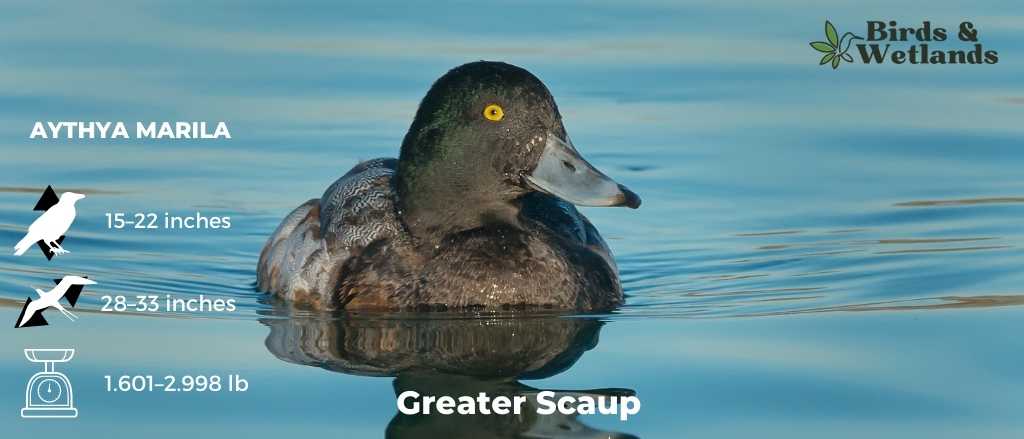

Listen:
Scientific Name: Aythya marila
Length: 15–22 in
Wingspan: 28–33 in
Weight: 1.601–2.998 lb
The Greater Scaup is a diving duck species found across North America, Europe, and Asia. This hardy bird is known for its preference for colder climates and ability to dive to impressive depths in search of food.
Appearance: The male Greater Scaup has a striking black head, neck, and chest, contrasted by a pale gray back and a white underbelly. Their heads have a greenish iridescence, and they have a blue-gray bill. Females, on the other hand, have a brown body with a white band at the base of the bill.
Diet: Greater Scaups are diving ducks and are capable of reaching depths of up to 6 meters to forage. Their diet primarily consists of aquatic invertebrates, such as mollusks and crustaceans, though they also consume plant matter including seeds and aquatic vegetation.
Reproduction: Greater Scaups breed in the northernmost parts of North America and Eurasia. They build nests on the ground near water, often on islands in lakes, shielded by vegetation. The female lays a clutch of around 9 eggs, and is solely responsible for incubation, which lasts about 24 to 28 days.
Lesser Scaup
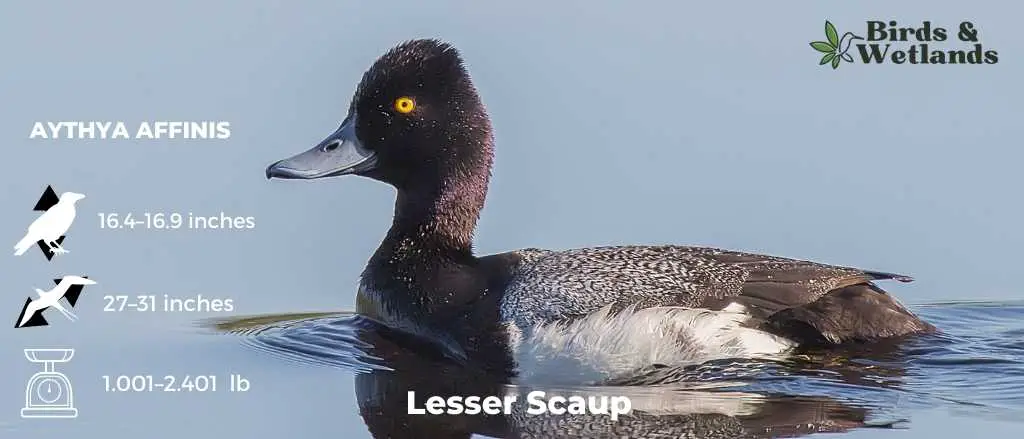
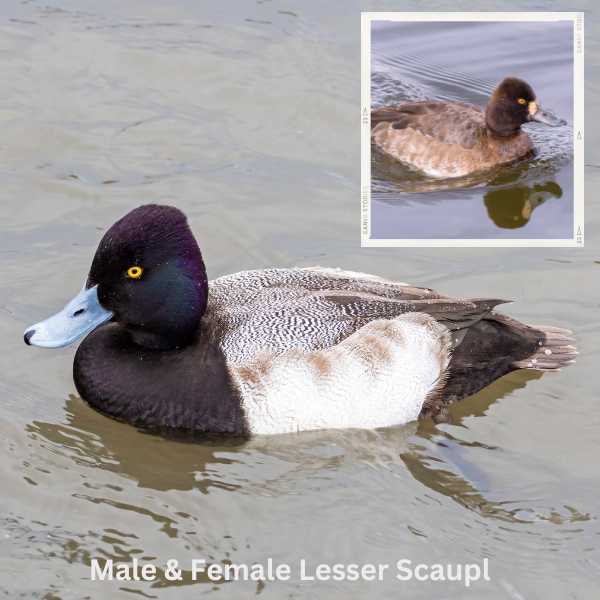
Listen
Scientific Name: Aythya affinis
Length: 16.4–16.9 in
Wingspan: 27–31 in
Weight: 1–2.4 lb
The Lesser Scaup is a small diving duck species commonly found in North America, particularly in the lakes, ponds, and coastal bays of the United States.
Appearance: Male Lesser Scaups are characterized by their glossy black heads and necks, bright yellow eyes, and pale bluish-gray backs. They also feature a distinguished black chest and tail-end. Females, on the other hand, are primarily brown with white bands near the bill and a slightly lighter brown color on their heads and necks.
Diet: Lesser Scaups are divers, and their diet mainly consists of aquatic invertebrates, including insects, mollusks, and crustaceans. They are also known to eat aquatic plants and seeds, particularly during the non-breeding season.
Reproduction: Lesser Scaups nest on the ground, generally close to water bodies. The female lays a clutch of around 9 to 11 eggs and is solely responsible for their incubation, which lasts for about three to four weeks.
Northern Pintail
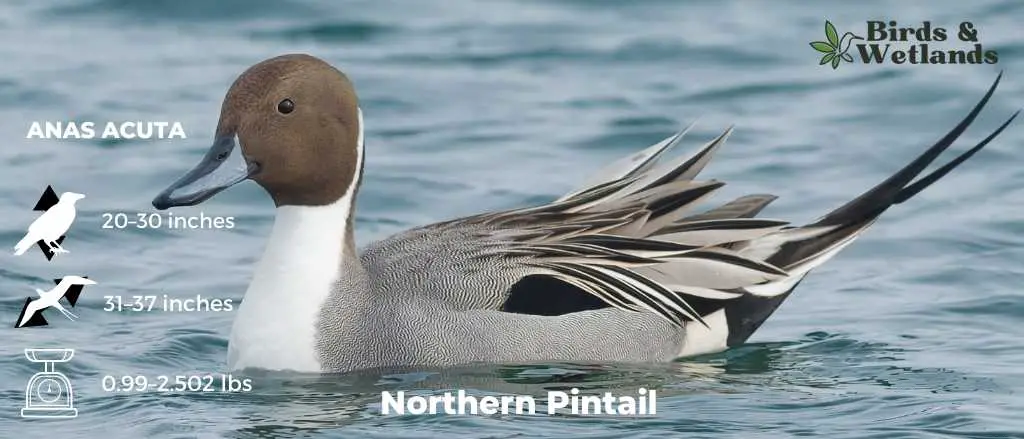
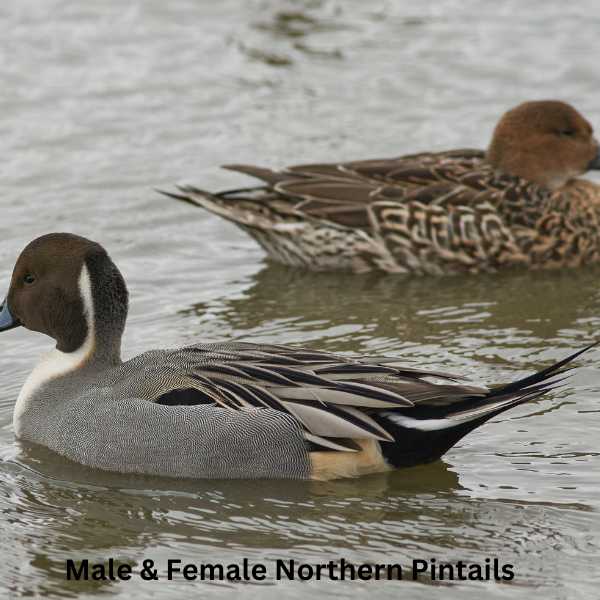
Listen to Northern Pintail
Scientific Name: Anas acuta
Length: 23–30 in
Wingspan: 31–37 in
Weight: 1 –3 lb
The Northern Pintail is a graceful species of duck recognized for their elegance in flight and their sleek bodies and long tails which is pin-shaped.
Male Northern Pintails are celebrated for their distinctive appearance, featuring a chocolate brown head, a white neck, and a grayish body. The most notable characteristic is the long, pointed tail feathers, which give this species its name. Females are more understated in color, sporting a mottled brown plumage.
Diet: Consists primarily of plant matter, including seeds and aquatic vegetation. They are also known to eat insects, especially during the breeding season. The Northern Pintail is often seen dabbling and upending in water bodies to forage for food.
Reproduction: Northern Pintails usually nest on the ground, near water bodies. The female lays a clutch of 7 to 9 eggs and is solely responsible for their incubation, which lasts for about three weeks.
Where to Spot Rhode Island’s Water Birds
Rhode Island, despite being the smallest state in the U.S., offers a plethora of great bird watching locations due to its coastal geography. Here are some locations where you can spot various species of water birds:
Sachuest Point National Wildlife Refuge, Middletown: This coastal refuge is an excellent place for spotting water birds and other wild birds like the Harlequin Duck, Red-breasted Merganser, and Double-Crested Cormorant. Its diverse habitats also attract migratory species.
Block Island National Wildlife Refuge, New Shoreham: Situated off the coast of Rhode Island, Block Island serves as an important stopover for migratory birds and other species due to its dense vegetation and abundance food supplies. You might see species like the American Black Duck, Greater Scaup, Snow goose (known for its pink legs) and Green Heron here.
Ninigret National Wildlife Refuge, Charlestown: Known for its large, diverse bird populations, you can observe numerous water bird species such as the Snowy Egret, Great Blue Heron, and the rare American Avocet. You will find many large birds here, as its their preferred habitat so look out for plenty of wading birds.
Trustom Pond National Wildlife Refuge, South Kingstown: As Rhode Island’s only undeveloped coastal pond, this refuge hosts over 300 bird species, including water birds like the American Coot, Northern Pintail, and Bufflehead.
Brenton Point State Park, Newport: This coastal park offers panoramic ocean views and opportunities to see various aquatic birds like the Brown Pelican, Western Grebe, and White-faced Ibis.
Are any water birds year round residents in Rhode Island?
Yes, over twelve species are year-round residents in Rhode Island. These birds have adapted to the changing seasons and can find sufficient food and shelter in the state throughout the year.
Here are a few examples of resident Waterbirds in Rhode island:
- Mallard: These ducks are extrememly common and often found in both freshwater and saltwater habitats in Rhode Island, and they remain throughout the winter.
- Canada Goose: The Canada Goose is a common sight in the state’s parks, golf courses, and other open areas, even your own backyard if you have a pool. Some populations are year-round residents and build their nest sites.
- American Black Duck: They inhabit the same areas as Mallards and are also year-round residents in Rhode Island.
- Great Blue Heron: This large wading bird can be found in the state’s marshes, ponds, and shores throughout the year.
- Belted Kingfisher: These birds are often seen along Rhode Island’s rivers and coasts, diving for fish, and are present year-round.
What kind of seabirds are in Rhode Island?
Rhode Island, being the Ocean State with plenty of coastline along the Atlantic, is home to a variety of seabirds. Seabirds are species that spend the majority of their lives at sea, venturing to land primarily for breeding purposes. Here are a few of the seabird species you can find in Rhode Island:
- Herring Gull: This large gull is very common along the coastlines of Rhode Island and can be seen year-round.
- Great Black-backed Gull: This is the largest species of gull and is commonly seen along the Rhode Island coast.
- Ring-billed Gull: These are also common gulls in Rhode Island, often seen in parking lots as well as along the coast.
- Common Tern: These seabirds are summer visitors to Rhode Island’s coastlines and can often be seen diving for fish.
- Least Tern: This is the smallest of the tern species and can be seen along the Rhode Island coast during the summer months.
- Double-crested Cormorant: These large water birds can be seen year-round in Rhode Island, often perched with their wings spread to dry.
- Northern Gannet: These impressive seabirds can sometimes be seen diving offshore, especially during migration seasons in spring and fall.
- Black-legged Kittiwake: This small gull species is more likely to be seen offshore in Rhode Island, especially in the winter.
- Laughing Gull: Recognizable by its black head and loud laugh-like call, these gulls are common summer visitors to Rhode Island’s coasts.
- Atlantic Puffin: It’s rare, but possible, to see Atlantic Puffins off the coast of Rhode Island, especially during winter storms when they get blown closer to shore.
It shoud be noted with the recent outbreak of Avian influenza (which has affected many species), the Rhode Island Department of Environmental Management are telling people if they see a dead bird, to avoid it and in no way come into contact with any dead birds. Many non-government conservation organizations are also contributing to these preventative measures.
| Neighboring State | Best Spots for Birdwatching |
|---|---|
| Connecticut Water Birds | Hammonasset Beach State Park, Sherwood Island State Park, Great Island Wildlife Area |
| Massachusetts Water Birds | Parker River National Wildlife Refuge, Cape Cod National Seashore, Plum Island |

